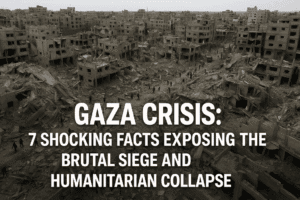Gaza Crisis: 7 Shocking Facts Exposing the Brutal Siege and Humanitarian Collapse
Israeli military strikes across Gaza killed over 100 Palestinians in 48 hours, including women and children, as attacks targeted homes, displaced families, and civilian infrastructure. In Beit Hanoun, Nusseirat, and Khan Younis, shelling and live fire struck shelters, schools, and residential areas, compounding the toll of a six-week blockade that has blocked food, fuel, and medical aid. Over 500,000 displaced civilians now face starvation and collapsing hospitals, with UN agencies warning of “catastrophic” shortages as Israel designates 30% of Gaza a no-go zone.
Since March, 1,189 Palestinians have died, including 212 children, while aid convoys are routinely blocked. With 51,000 confirmed dead since October 2023—and thousands buried under rubble—the crisis exposes systemic failures to protect civilians or uphold international law. The UN condemns Israel’s indefinite military plans in Gaza, Lebanon, and Syria, as survivors endure unimaginable choices: fleeing bombs or facing starvation. Gaza’s unraveling demands urgent global intervention before silence becomes complicity.

Gaza Crisis: 7 Shocking Facts Exposing the Brutal Siege and Humanitarian Collapse
The Gaza Strip faces a harrowing escalation of violence as Israeli military operations intensify, compounding an already dire humanitarian crisis. Over recent days, airstrikes, shelling, and live fire have claimed dozens of Palestinian lives, underscoring the devastating toll on civilians trapped in one of the world’s most densely populated regions.
Immediate Toll: Civilians Caught in Crossfire
In Beit Hanoun, northern Gaza, missile attacks on displaced Palestinians killed at least two, while live fire east of the city claimed another life. Central Gaza’s Nusseirat refugee camp saw a home near Al-Orouba School struck, killing Ahmad Mahmoud Siyam and injuring others. A separate strike in western Nusseirat killed a woman, highlighting the indiscriminate nature of the assaults.
Further south, Khan Younis endured heavy bombardment, with the Esleem family home in Qizan Najjar destroyed, killing Mohammad Essam Najjar and Abed Mohammad Najjar. Families sheltering in makeshift camps in Mawasi Khan Younis were not spared, as shelling left one dead and multiple injured.
A Collapsing Humanitarian Lifeline
The UN warns of a “catastrophic” collapse in Gaza’s infrastructure due to Israel’s six-week blockade, severing access to food, fuel, and medical supplies. UNRWA reports critical fuel shortages, paralyzing bakeries, hospitals, and generators. Over 500,000 people have been displaced since mid-March, many fleeing for the second time amid relentless strikes.
Aid efforts face insurmountable hurdles: Israeli authorities blocked four missions this week, including urgent fuel retrieval in Rafah. Stéphane Dujarric, spokesperson for the UN Secretary-General, condemned Israel’s expansion of “security zones”—30% of Gaza is now a no-go area for Palestinians, deepening displacement and resource scarcity.
The Unseen Wounds: Beyond the Death Toll
Casualty figures since March 18 reveal 1,189 Palestinians killed, including 212 children and 128 women. Since October 2023, over 51,000 deaths have been confirmed, with thousands more buried under rubble. The loss of 235 journalists, 23 medical staff, and 203 UN workers cripples Gaza’s ability to document and respond to the crisis.
Hospitals, already depleted by months of siege, now operate without anesthesia or antibiotics. A nurse in Khan Younis described reusing gloves and treating burns with vinegar. Meanwhile, parents face impossible choices—feeding children scraps or risking bombed streets to seek aid.
International Paralysis and the Path Forward
The UN’s repeated calls for ceasefires and aid access remain unheeded. Israel’s stated goal of dismantling militant infrastructure clashes with the reality of civilian suffering, raising ethical questions about proportionality in warfare. With plans for an indefinite military presence in Gaza, Lebanon, and Syria, prospects for peace dim.
Voices from the Rubble
Amid the statistics lie human stories: A father in Zawaida mourns his sons, killed while fetching water. A teacher in Nusseirat recounts converting classrooms into shelters, only to see them bombed. These narratives underscore the urgency of global intervention.
Conclusion: A Crisis Demanding Action
Gaza’s plight is not merely a conflict statistic but a test of humanity’s conscience. As the world grapples with geopolitical complexities, civilians pay the price. Will the international community prioritize diplomacy over destruction, or will Gaza’s cries for help fade into silence? The clock is ticking—for every delayed aid convoy, another life hangs in the balance.
You must be logged in to post a comment.